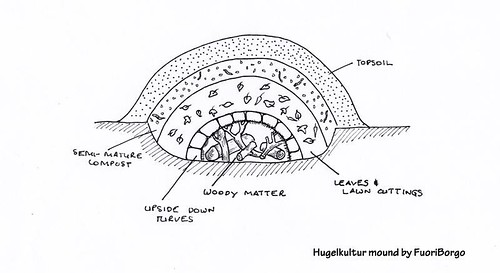We spent last week up in Te Puke at my mother-in-law's place. Judy is a keen gardener and eats more vegetables than anyone I know, most of which she grows in her backyard. This year, alongside her traditional vegetable patches, Judy has also set up a hugelkultur garden to try and extend her growing season.
 |
| One of Judy's vegetable patches - conventional on the left and hugelkultur on the right. |
What is hugelkultur?
Hugelkultur (German for hill culture) is the practice of composting large woody material to create a raised garden bed. It is a good way of dealing with woody garden waste such as prunings, hedge clippings and brassica stems.
The technique involves digging a trench in the ground and filling it with woody materials. Grass or turf (face-down) is then stacked on top, followed by layers of compost, well rotted leaves and manure, etc as available. The layers break down slowly, creating rich humus over four to five years.
As the years pass, the deep soil of the raised bed becomes rich and loaded with soil life. As the wood shrinks, it makes tiny air pockets - so your hugelkultur becomes self tilling. In the first few years the composting process will slightly warm the soil, extending the growing season in temperate and cold climates.
The wood also stores large volumes of water, making this an excellent gardening system for arid regions.
It's best to use wood that is well rotted down, to prevent it from sucking the nitrogen out of your soil. This is because new wood is high in carbon, so requires a lot of nitrogen to compost.
How to build a hugelkultur garden
1. In autumn or early winter, choose a sunny spot in your yard.
2. Dig a 1.5 metre wide trench, keeping the turf as you dig. Orient the trench north-south and make it as long as possible.
3. Put your woody material at the bottom, eg. well-rotted branches and logs, or hedge clippings and broccoli stalks.
4. Next layer in your turf, turned upside down with the roots facing up so the grass won't keep growing.
5. Now layer in garden waste, leaves and grass clippings from other parts of your lawn.
6. Next layer semi-mature compost over the curve.
7. Cover the whole pile with a layer of soil you got when you dug your trench. Alternatively, if your soil wasn't any good (eg. full of oxalis bulbs), you may want to bring in good quality topsoil from another source for this top layer.
8. Because the garden is mounded, you will need to plant it with a cover crop (eg. mustard) immediately to prevent erosion over winter.
9. Your hugelkultur garden will be ready for planting with vegetable crops in spring.
Here's a diagram I found over at The Simple Green Frugal Co-op Blog.

How Judy's hugelkultur garden is going
 |
| Judy's newly planted hugelkultur garden. |
- Early days still: Judy's plants aren't growing as fast as she was expecting since the garden was started in autumn and planted in winter. Judy is now thinking of covering it in plastic to create a greenhouse effect. The warm composting soil underneath will provide warmth while the plastic will combat cold air temperatures.
How my pseudo-hugelkultur raised garden is going
 |
| My hugelkultur-esk raised garden still going strong in the middle of winter. |
- Noticeably longer growing season: I planted my silverbeet and spinach in spring and still have quite a bit of it growing in my raised garden. I suspect the composting wood at the bottom of my garden has helped keep the soil warm over winter. That's good news because my raised garden doesn't get a lot of sun these wintery days.
- Seaweed provided the much needed nitrogen: I didn't have grass clippings to add to my garden, but I did layer seaweed directly above my woody layer. At the time I was only thinking about providing nitrogen for my plants to grow, but after researching for this post I realise it would have also helped my (not very rotten) wood to compost.
- Less weeds: One thing I've noticed about hugelkultur gardens is they don't get as weedy as conventional gardens. My guess is that the woody layer acts as a deterrent to weeds.
- Frugal: Hugelkultur allowed me to bulk out my raised beds with garden waste, instead of even more bags of soil and compost from the garden centre.


I didn't realize this kind of gardening had a name! I was researching what to put in my new raised beds and came across several sites that said to fill up your bottom layers with hedge clippings and dead branches/garden waste, so I did! I didn't have any grass clippings though, but raided our compost bin for what scraps were in there.
ReplyDeleteCool post!
Hey Gwen, I don't think hugelkultur is very well known, but it's a great way to repurpose garden waste and create a healthier garden.
ReplyDelete